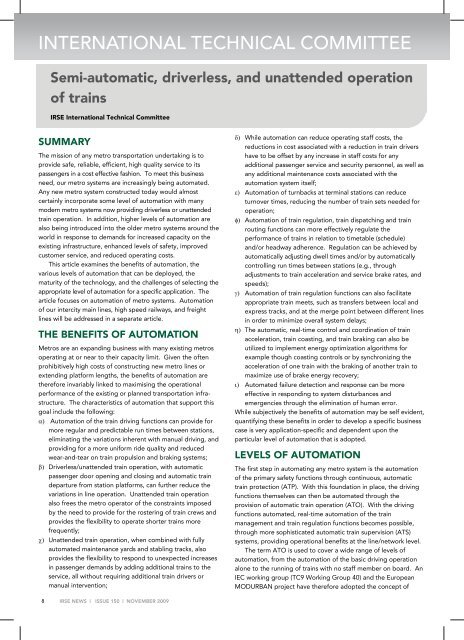IRSE News 150 Nov 09.pdf
IRSE News 150 Nov 09.pdf
IRSE News 150 Nov 09.pdf
You also want an ePaper? Increase the reach of your titles
YUMPU automatically turns print PDFs into web optimized ePapers that Google loves.
INTERNATIONAL TECHNICAL COMMITTEE<br />
Semi-automatic, driverless, and unattended operation<br />
of trains<br />
<strong>IRSE</strong> International Technical Committee<br />
SUMMARY<br />
The mission of any metro transportation undertaking is to<br />
provide safe, reliable, efficient, high quality service to its<br />
passengers in a cost effective fashion. To meet this business<br />
need, our metro systems are increasingly being automated.<br />
Any new metro system constructed today would almost<br />
certainly incorporate some level of automation with many<br />
modern metro systems now providing driverless or unattended<br />
train operation. In addition, higher levels of automation are<br />
also being introduced into the older metro systems around the<br />
world in response to demands for increased capacity on the<br />
existing infrastructure, enhanced levels of safety, improved<br />
customer service, and reduced operating costs.<br />
This article examines the benefits of automation, the<br />
various levels of automation that can be deployed, the<br />
maturity of the technology, and the challenges of selecting the<br />
appropriate level of automation for a specific application. The<br />
article focuses on automation of metro systems. Automation<br />
of our intercity main lines, high speed railways, and freight<br />
lines will be addressed in a separate article.<br />
THE BENEFITS OF AUTOMATION<br />
Metros are an expanding business with many existing metros<br />
operating at or near to their capacity limit. Given the often<br />
prohibitively high costs of constructing new metro lines or<br />
extending platform lengths, the benefits of automation are<br />
therefore invariably linked to maximising the operational<br />
performance of the existing or planned transportation infrastructure.<br />
The characteristics of automation that support this<br />
goal include the following:<br />
Automation of the train driving functions can provide for<br />
more regular and predictable run times between stations,<br />
eliminating the variations inherent with manual driving, and<br />
providing for a more uniform ride quality and reduced<br />
wear-and-tear on train propulsion and braking systems;<br />
Driverless/unattended train operation, with automatic<br />
passenger door opening and closing and automatic train<br />
departure from station platforms, can further reduce the<br />
variations in line operation. Unattended train operation<br />
also frees the metro operator of the constraints imposed<br />
by the need to provide for the rostering of train crews and<br />
provides the flexibility to operate shorter trains more<br />
frequently;<br />
Unattended train operation, when combined with fully<br />
automated maintenance yards and stabling tracks, also<br />
provides the flexibility to respond to unexpected increases<br />
in passenger demands by adding additional trains to the<br />
service, all without requiring additional train drivers or<br />
manual intervention;<br />
While automation can reduce operating staff costs, the<br />
reductions in cost associated with a reduction in train drivers<br />
have to be offset by any increase in staff costs for any<br />
additional passenger service and security personnel, as well as<br />
any additional maintenance costs associated with the<br />
automation system itself;<br />
Automation of turnbacks at terminal stations can reduce<br />
turnover times, reducing the number of train sets needed for<br />
operation;<br />
Automation of train regulation, train dispatching and train<br />
routing functions can more effectively regulate the<br />
performance of trains in relation to timetable (schedule)<br />
and/or headway adherence. Regulation can be achieved by<br />
automatically adjusting dwell times and/or by automatically<br />
controlling run times between stations (e.g., through<br />
adjustments to train acceleration and service brake rates, and<br />
speeds);<br />
Automation of train regulation functions can also facilitate<br />
appropriate train meets, such as transfers between local and<br />
express tracks, and at the merge point between different lines<br />
in order to minimize overall system delays;<br />
The automatic, real-time control and coordination of train<br />
acceleration, train coasting, and train braking can also be<br />
utilized to implement energy optimization algorithms for<br />
example though coasting controls or by synchronizing the<br />
acceleration of one train with the braking of another train to<br />
maximize use of brake energy recovery;<br />
Automated failure detection and response can be more<br />
effective in responding to system disturbances and<br />
emergencies through the elimination of human error.<br />
While subjectively the benefits of automation may be self evident,<br />
quantifying these benefits in order to develop a specific business<br />
case is very application-specific and dependent upon the<br />
particular level of automation that is adopted.<br />
LEVELS OF AUTOMATION<br />
The first step in automating any metro system is the automation<br />
of the primary safety functions through continuous, automatic<br />
train protection (ATP). With this foundation in place, the driving<br />
functions themselves can then be automated through the<br />
provision of automatic train operation (ATO). With the driving<br />
functions automated, real-time automation of the train<br />
management and train regulation functions becomes possible,<br />
through more sophisticated automatic train supervision (ATS)<br />
systems, providing operational benefits at the line/network level.<br />
The term ATO is used to cover a wide range of levels of<br />
automation, from the automation of the basic driving operation<br />
alone to the running of trains with no staff member on board. An<br />
IEC working group (TC9 Working Group 40) and the European<br />
MODURBAN project have therefore adopted the concept of<br />
8<br />
<strong>IRSE</strong> NEWS | ISSUE <strong>150</strong> | NOVEMBER 2009

















